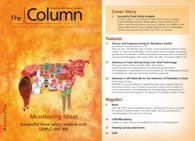Analyzing Dolphin Breath
A new study published in the journal Analytical Chemistry by scientists from the University of California Davis, the National Marine Mammal Foundation, and the Chicago Zoological Society in the USA presents a novel breath analysis method for Atlantic bottlenose dolphins (Tursiops truncatus) that could be used to monitor and assess the health of wild marine mammal populations.
Photo Credit: Martin Ruegner/Getty Images

A new study published in the journal Analytical Chemistry by scientists from the University of California Davis, the National Marine Mammal Foundation, and the Chicago Zoological Society in the USA presents a novel breath analysis method for Atlantic bottlenose dolphins (Tursiops truncatus) that could be used to monitor and assess the health of wild marine mammal populations.1
Health assessment of marine mammals typically requires the collection of biological samples, which can be challenging, especially when monitoring larger marine mammals. The health of dolphins can be linked to changes in the ocean environment because their layer of energy‑storing blubber can trap chemicals and toxins absorbed through the skin. They can therefore be monitored and studied to identify environmental changes that can impact other marine mammals which are more difficult to monitor, such as whales. This is particularly important when investigating unusual mortality events (UMEs), which are defined as the stranding of marine animals that is unexpected, causing significant die-off, and demanding an immediate response.2
Corresponding author Cristina E. Davis told The Column: “My research group is interested in non-invasive chemical sensing of biological metabolites. We have previously looked at exhaled biomarker metabolites in humans, and this study represents the first time we could apply this approach to an animal system. Bottlenose dolphins are such an important species, and this may be able to help provide health information for them.”
The study authors developed an exhaled breath condensate (EBC) collection device specifically adapted for marine mammal anatomy and physiology. Samples were taken from 13 managed animals over a course of five days as part of the U.S. Navy Marine Mammal Programme in San Diego, California, USA. Trainers positioned the dolphins and the sampler was held over the blowhole for 5 min or 10–20 breaths. Samples were also taken from a wild dolphin population in Sarasota Bay in Florida, USA, as part of a research programme performed by the Chicago Zoological Society’s Sarasota Dolphin Research programme, but in this case the sampling device was not permitted to touch the animal.
Volatile organic compounds (VOCs) were sampled from the headspace of the collected condensate samples using solid-phase microextraction (SPME) and subsequently analyzed using gas chromatography–mass spectrometry (GC–MS). The nonvolatile fraction was analyzed using liquid chromatography–mass spectrometry (LC–MS) analysis. According to the paper, the breath samples were very complex mixtures containing a wide variety of low-abundance metabolites, some of which are also present in human breath. Compounds were also detected that were from external sources, including: phthalates; 2,4-diisocyanato-1-methyl-benzene; 2,6-bis(1,1-dimethylethyl)- 2,5-cyclohexadiene-1,4-dione; and some of the long chain alcohols.
Davis said: “We found that exhaled dolphin breath contains many metabolites, and we could sample these metabolites non-invasively and reproducibly. This paves the way to use breath diagnostics as a new health management tool for this important animal population.” — B.D.
References
1. Alexander A. Aksenov et al.,Analytical Chemistry DOI: 10.1021/ac5024217 (2014).
2. http://www.nmfs.noaa.gov/pr/health/mmume/
This story originally appeared in The Column. Click here to view that issue.

Determining Enhanced Sensitivity to Odors due to Anxiety-Associated Chemosignals with GC
May 8th 2025Based on their hypothesis that smelling anxiety chemosignals can, like visual anxiety induction, lead to an increase in odor sensitivity, a joint study between the University of Erlangen-Nuremberg (Erlangen, Germany) and the Fraunhofer Institute for Process Engineering and Packaging (Freising, Germany) combined behavioral experiments, odor profile analysis by a trained panel, and instrumental analysis of odorants (gas chromatography-olfactometry) and volatiles (gas chromatography-mass spectrometry).
Investigating 3D-Printable Stationary Phases in Liquid Chromatography
May 7th 20253D printing technology has potential in chromatography, but a major challenge is developing materials with both high porosity and robust mechanical properties. Recently, scientists compared the separation performances of eight different 3D printable stationary phases.
Detecting Hyper-Fast Chromatographic Peaks Using Ion Mobility Spectrometry
May 6th 2025Ion mobility spectrometers can detect trace compounds quickly, though they can face various issues with detecting certain peaks. University of Hannover scientists created a new system for resolving hyper-fast gas chromatography (GC) peaks.

.png&w=3840&q=75)

.png&w=3840&q=75)



.png&w=3840&q=75)



.png&w=3840&q=75)









